Organizational Behaviour Report: Motivation and Team Dynamics
VerifiedAdded on 2021/02/20
|21
|5787
|24
Report
AI Summary
This report delves into the realm of organizational behaviour, focusing on its application within Tesco Plc. It begins by examining the impact of organizational culture, politics, and power on individual and team dynamics, highlighting how these factors shape employee behaviour and performance. The report then explores motivational theories, specifically Maslow's Hierarchy of Needs and Herzberg's Two-Factor Theory, to understand how these frameworks can be leveraged to achieve organizational goals and foster a positive work environment. Furthermore, the analysis extends to team effectiveness, contrasting the characteristics of effective and ineffective teams, and discussing the concepts and philosophies that underpin organizational behaviour. The report underscores the importance of these elements in shaping the overall success and sustainability of a large retail organization like Tesco.
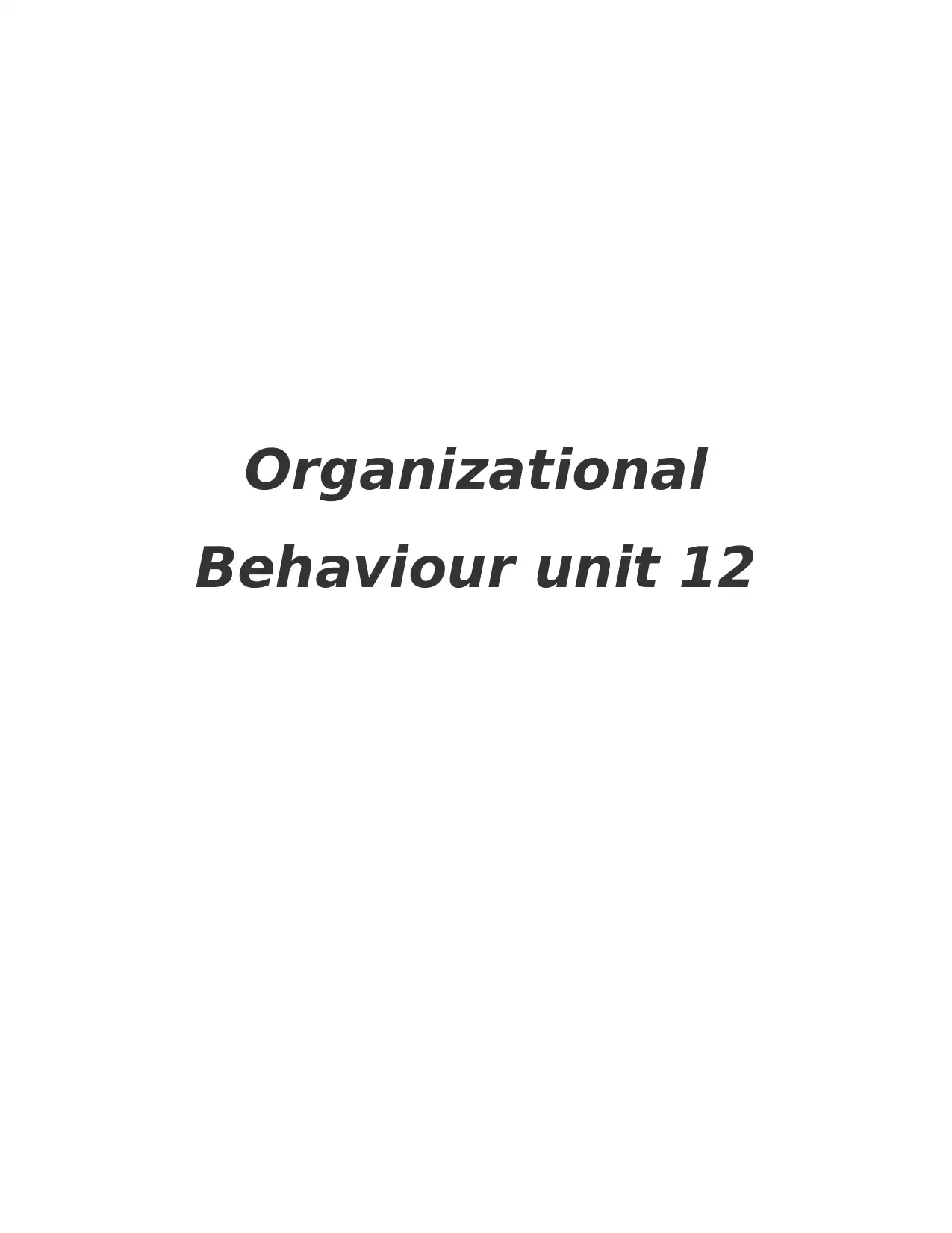
Organizational
Behaviour unit 12
Behaviour unit 12
Paraphrase This Document
Need a fresh take? Get an instant paraphrase of this document with our AI Paraphraser
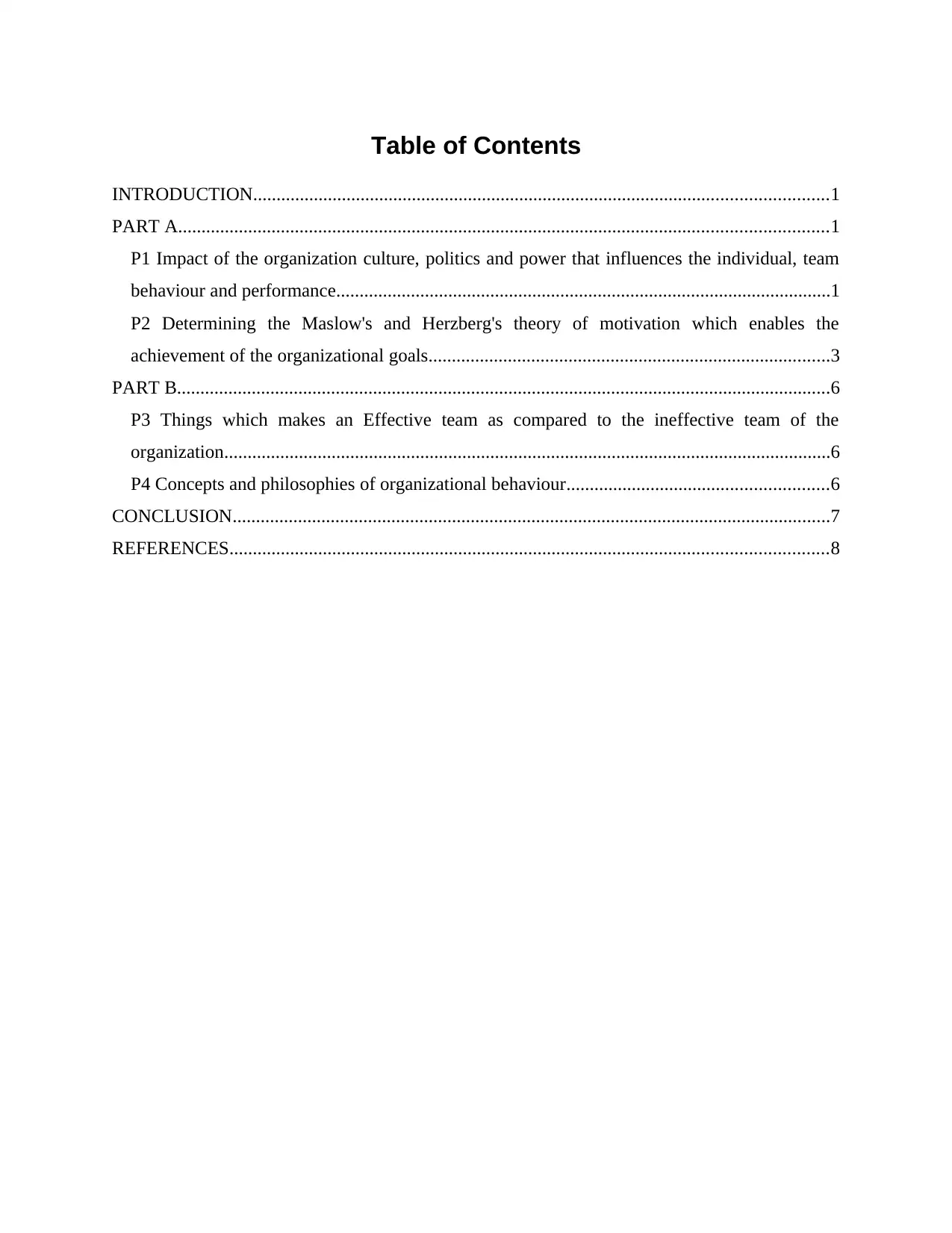
Table of Contents
INTRODUCTION...........................................................................................................................1
PART A...........................................................................................................................................1
P1 Impact of the organization culture, politics and power that influences the individual, team
behaviour and performance..........................................................................................................1
P2 Determining the Maslow's and Herzberg's theory of motivation which enables the
achievement of the organizational goals......................................................................................3
PART B............................................................................................................................................6
P3 Things which makes an Effective team as compared to the ineffective team of the
organization..................................................................................................................................6
P4 Concepts and philosophies of organizational behaviour........................................................6
CONCLUSION................................................................................................................................7
REFERENCES................................................................................................................................8
INTRODUCTION...........................................................................................................................1
PART A...........................................................................................................................................1
P1 Impact of the organization culture, politics and power that influences the individual, team
behaviour and performance..........................................................................................................1
P2 Determining the Maslow's and Herzberg's theory of motivation which enables the
achievement of the organizational goals......................................................................................3
PART B............................................................................................................................................6
P3 Things which makes an Effective team as compared to the ineffective team of the
organization..................................................................................................................................6
P4 Concepts and philosophies of organizational behaviour........................................................6
CONCLUSION................................................................................................................................7
REFERENCES................................................................................................................................8
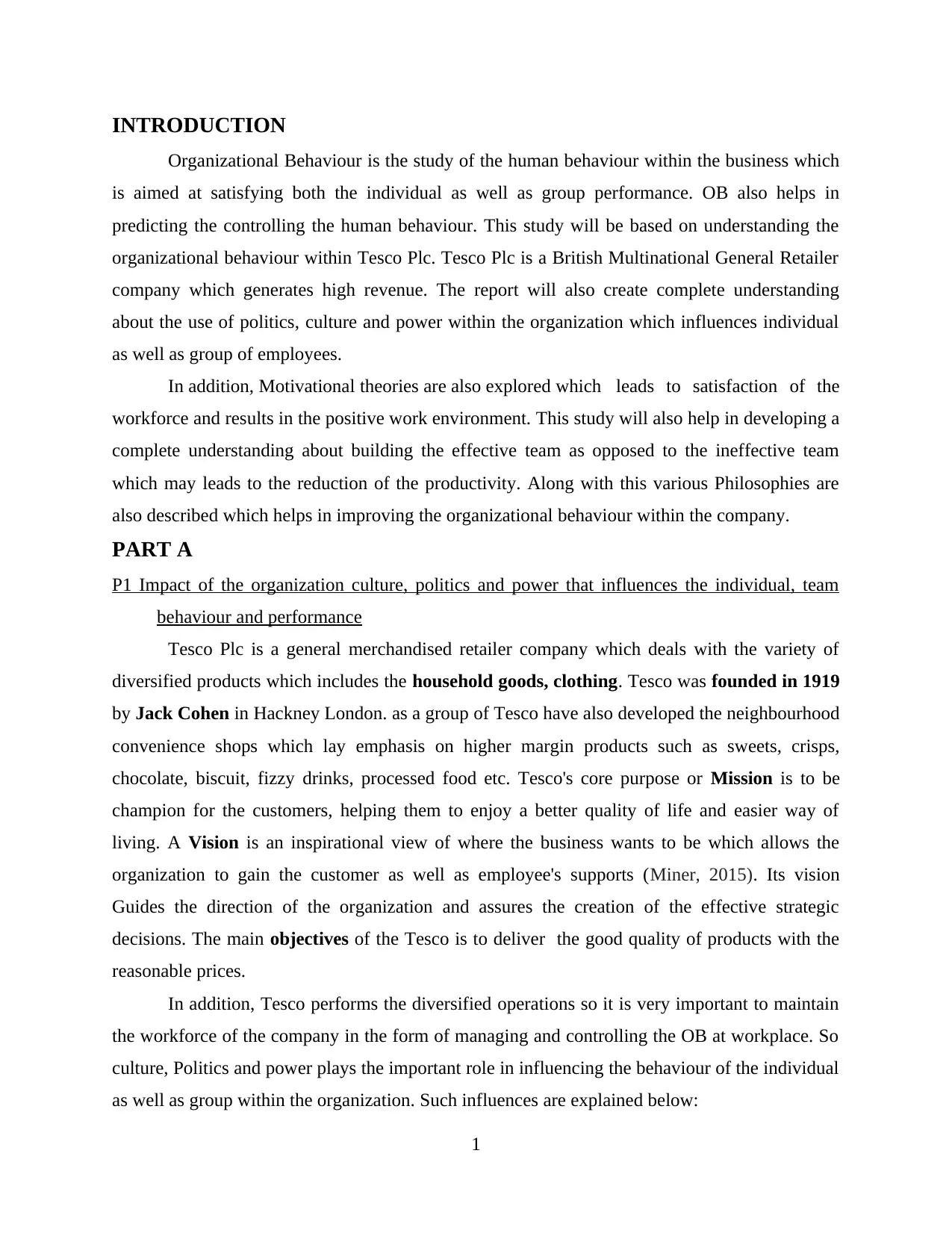
INTRODUCTION
Organizational Behaviour is the study of the human behaviour within the business which
is aimed at satisfying both the individual as well as group performance. OB also helps in
predicting the controlling the human behaviour. This study will be based on understanding the
organizational behaviour within Tesco Plc. Tesco Plc is a British Multinational General Retailer
company which generates high revenue. The report will also create complete understanding
about the use of politics, culture and power within the organization which influences individual
as well as group of employees.
In addition, Motivational theories are also explored which leads to satisfaction of the
workforce and results in the positive work environment. This study will also help in developing a
complete understanding about building the effective team as opposed to the ineffective team
which may leads to the reduction of the productivity. Along with this various Philosophies are
also described which helps in improving the organizational behaviour within the company.
PART A
P1 Impact of the organization culture, politics and power that influences the individual, team
behaviour and performance
Tesco Plc is a general merchandised retailer company which deals with the variety of
diversified products which includes the household goods, clothing. Tesco was founded in 1919
by Jack Cohen in Hackney London. as a group of Tesco have also developed the neighbourhood
convenience shops which lay emphasis on higher margin products such as sweets, crisps,
chocolate, biscuit, fizzy drinks, processed food etc. Tesco's core purpose or Mission is to be
champion for the customers, helping them to enjoy a better quality of life and easier way of
living. A Vision is an inspirational view of where the business wants to be which allows the
organization to gain the customer as well as employee's supports (Miner, 2015). Its vision
Guides the direction of the organization and assures the creation of the effective strategic
decisions. The main objectives of the Tesco is to deliver the good quality of products with the
reasonable prices.
In addition, Tesco performs the diversified operations so it is very important to maintain
the workforce of the company in the form of managing and controlling the OB at workplace. So
culture, Politics and power plays the important role in influencing the behaviour of the individual
as well as group within the organization. Such influences are explained below:
1
Organizational Behaviour is the study of the human behaviour within the business which
is aimed at satisfying both the individual as well as group performance. OB also helps in
predicting the controlling the human behaviour. This study will be based on understanding the
organizational behaviour within Tesco Plc. Tesco Plc is a British Multinational General Retailer
company which generates high revenue. The report will also create complete understanding
about the use of politics, culture and power within the organization which influences individual
as well as group of employees.
In addition, Motivational theories are also explored which leads to satisfaction of the
workforce and results in the positive work environment. This study will also help in developing a
complete understanding about building the effective team as opposed to the ineffective team
which may leads to the reduction of the productivity. Along with this various Philosophies are
also described which helps in improving the organizational behaviour within the company.
PART A
P1 Impact of the organization culture, politics and power that influences the individual, team
behaviour and performance
Tesco Plc is a general merchandised retailer company which deals with the variety of
diversified products which includes the household goods, clothing. Tesco was founded in 1919
by Jack Cohen in Hackney London. as a group of Tesco have also developed the neighbourhood
convenience shops which lay emphasis on higher margin products such as sweets, crisps,
chocolate, biscuit, fizzy drinks, processed food etc. Tesco's core purpose or Mission is to be
champion for the customers, helping them to enjoy a better quality of life and easier way of
living. A Vision is an inspirational view of where the business wants to be which allows the
organization to gain the customer as well as employee's supports (Miner, 2015). Its vision
Guides the direction of the organization and assures the creation of the effective strategic
decisions. The main objectives of the Tesco is to deliver the good quality of products with the
reasonable prices.
In addition, Tesco performs the diversified operations so it is very important to maintain
the workforce of the company in the form of managing and controlling the OB at workplace. So
culture, Politics and power plays the important role in influencing the behaviour of the individual
as well as group within the organization. Such influences are explained below:
1
⊘ This is a preview!⊘
Do you want full access?
Subscribe today to unlock all pages.

Trusted by 1+ million students worldwide
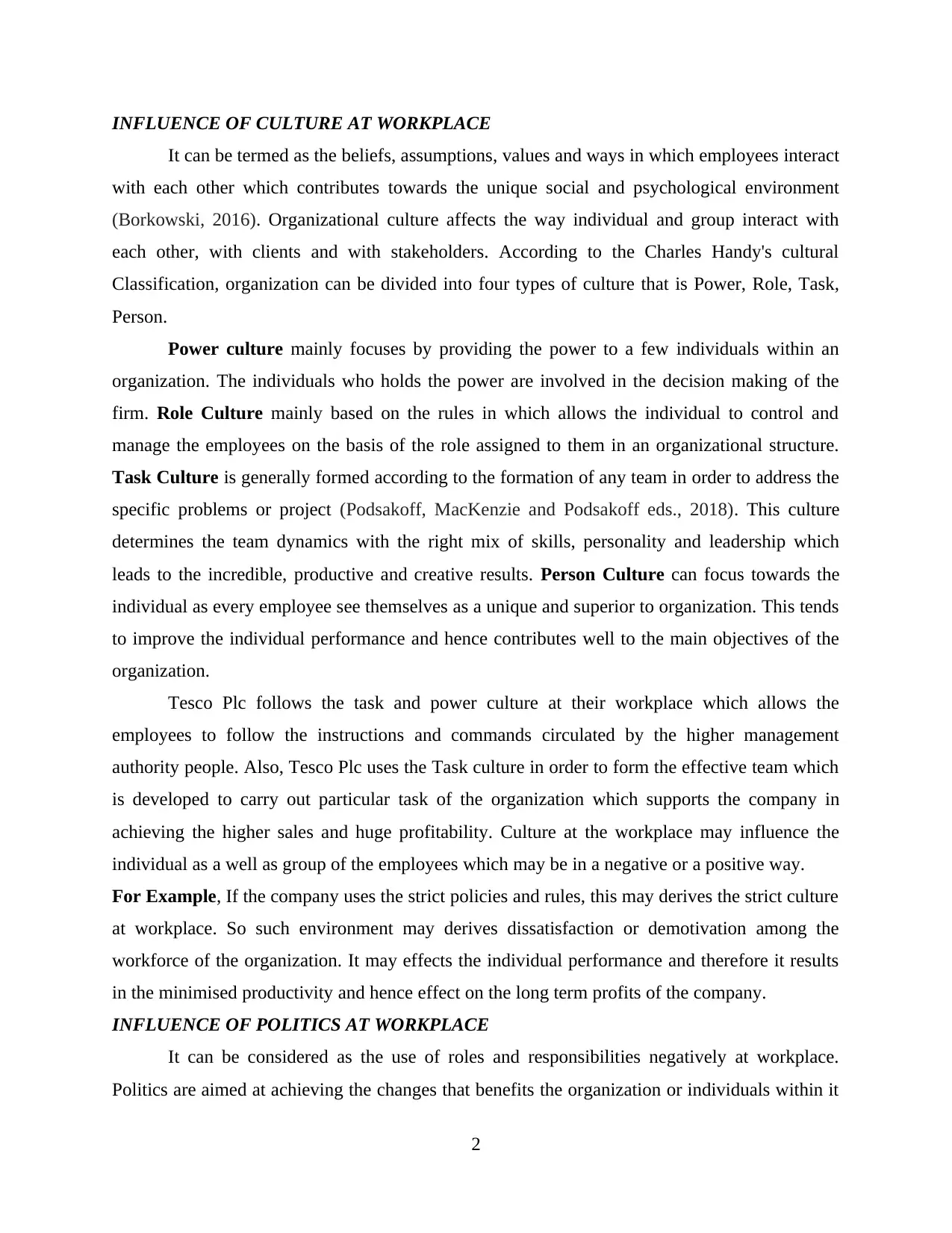
INFLUENCE OF CULTURE AT WORKPLACE
It can be termed as the beliefs, assumptions, values and ways in which employees interact
with each other which contributes towards the unique social and psychological environment
(Borkowski, 2016). Organizational culture affects the way individual and group interact with
each other, with clients and with stakeholders. According to the Charles Handy's cultural
Classification, organization can be divided into four types of culture that is Power, Role, Task,
Person.
Power culture mainly focuses by providing the power to a few individuals within an
organization. The individuals who holds the power are involved in the decision making of the
firm. Role Culture mainly based on the rules in which allows the individual to control and
manage the employees on the basis of the role assigned to them in an organizational structure.
Task Culture is generally formed according to the formation of any team in order to address the
specific problems or project (Podsakoff, MacKenzie and Podsakoff eds., 2018). This culture
determines the team dynamics with the right mix of skills, personality and leadership which
leads to the incredible, productive and creative results. Person Culture can focus towards the
individual as every employee see themselves as a unique and superior to organization. This tends
to improve the individual performance and hence contributes well to the main objectives of the
organization.
Tesco Plc follows the task and power culture at their workplace which allows the
employees to follow the instructions and commands circulated by the higher management
authority people. Also, Tesco Plc uses the Task culture in order to form the effective team which
is developed to carry out particular task of the organization which supports the company in
achieving the higher sales and huge profitability. Culture at the workplace may influence the
individual as a well as group of the employees which may be in a negative or a positive way.
For Example, If the company uses the strict policies and rules, this may derives the strict culture
at workplace. So such environment may derives dissatisfaction or demotivation among the
workforce of the organization. It may effects the individual performance and therefore it results
in the minimised productivity and hence effect on the long term profits of the company.
INFLUENCE OF POLITICS AT WORKPLACE
It can be considered as the use of roles and responsibilities negatively at workplace.
Politics are aimed at achieving the changes that benefits the organization or individuals within it
2
It can be termed as the beliefs, assumptions, values and ways in which employees interact
with each other which contributes towards the unique social and psychological environment
(Borkowski, 2016). Organizational culture affects the way individual and group interact with
each other, with clients and with stakeholders. According to the Charles Handy's cultural
Classification, organization can be divided into four types of culture that is Power, Role, Task,
Person.
Power culture mainly focuses by providing the power to a few individuals within an
organization. The individuals who holds the power are involved in the decision making of the
firm. Role Culture mainly based on the rules in which allows the individual to control and
manage the employees on the basis of the role assigned to them in an organizational structure.
Task Culture is generally formed according to the formation of any team in order to address the
specific problems or project (Podsakoff, MacKenzie and Podsakoff eds., 2018). This culture
determines the team dynamics with the right mix of skills, personality and leadership which
leads to the incredible, productive and creative results. Person Culture can focus towards the
individual as every employee see themselves as a unique and superior to organization. This tends
to improve the individual performance and hence contributes well to the main objectives of the
organization.
Tesco Plc follows the task and power culture at their workplace which allows the
employees to follow the instructions and commands circulated by the higher management
authority people. Also, Tesco Plc uses the Task culture in order to form the effective team which
is developed to carry out particular task of the organization which supports the company in
achieving the higher sales and huge profitability. Culture at the workplace may influence the
individual as a well as group of the employees which may be in a negative or a positive way.
For Example, If the company uses the strict policies and rules, this may derives the strict culture
at workplace. So such environment may derives dissatisfaction or demotivation among the
workforce of the organization. It may effects the individual performance and therefore it results
in the minimised productivity and hence effect on the long term profits of the company.
INFLUENCE OF POLITICS AT WORKPLACE
It can be considered as the use of roles and responsibilities negatively at workplace.
Politics are aimed at achieving the changes that benefits the organization or individuals within it
2
Paraphrase This Document
Need a fresh take? Get an instant paraphrase of this document with our AI Paraphraser
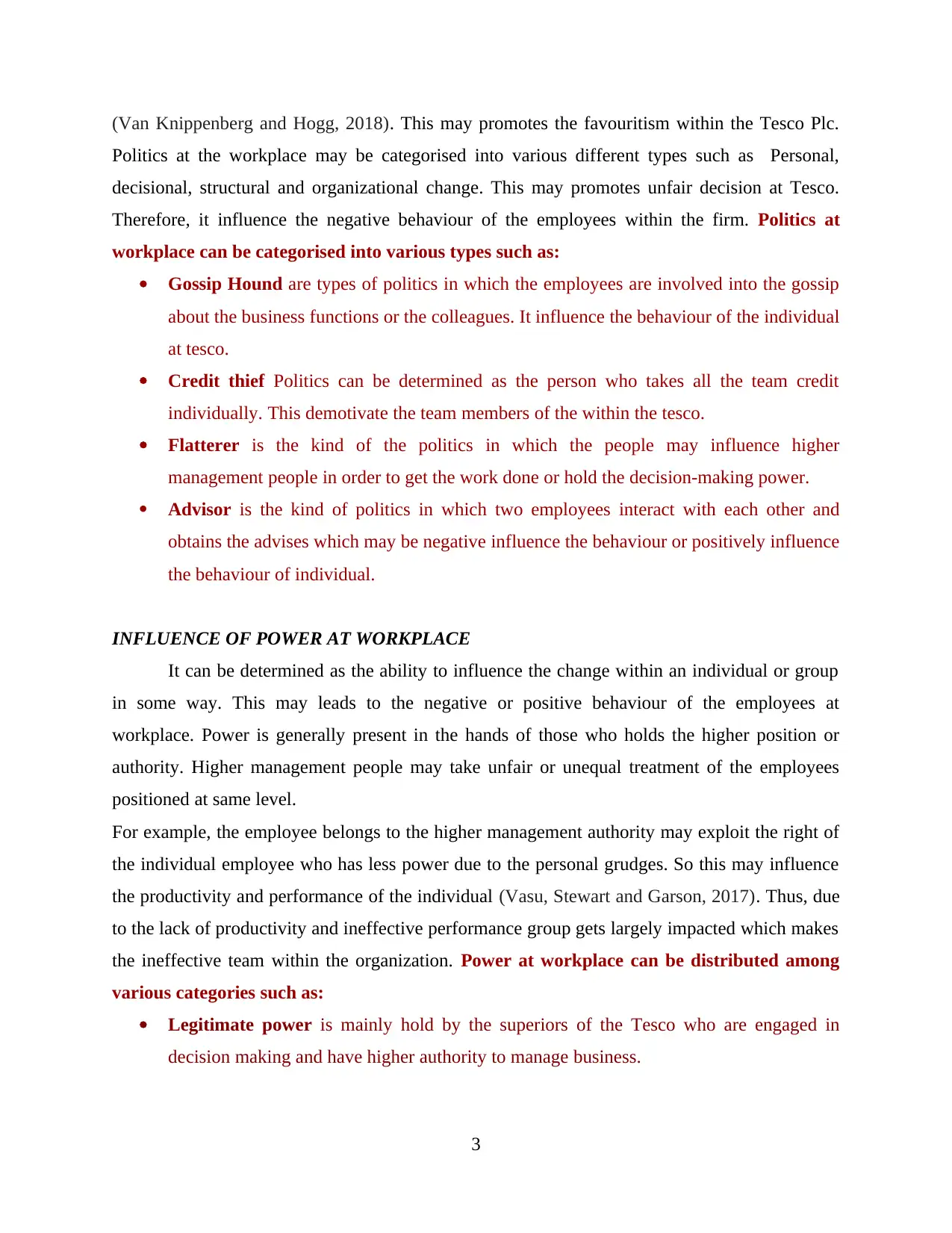
(Van Knippenberg and Hogg, 2018). This may promotes the favouritism within the Tesco Plc.
Politics at the workplace may be categorised into various different types such as Personal,
decisional, structural and organizational change. This may promotes unfair decision at Tesco.
Therefore, it influence the negative behaviour of the employees within the firm. Politics at
workplace can be categorised into various types such as:
Gossip Hound are types of politics in which the employees are involved into the gossip
about the business functions or the colleagues. It influence the behaviour of the individual
at tesco.
Credit thief Politics can be determined as the person who takes all the team credit
individually. This demotivate the team members of the within the tesco.
Flatterer is the kind of the politics in which the people may influence higher
management people in order to get the work done or hold the decision-making power.
Advisor is the kind of politics in which two employees interact with each other and
obtains the advises which may be negative influence the behaviour or positively influence
the behaviour of individual.
INFLUENCE OF POWER AT WORKPLACE
It can be determined as the ability to influence the change within an individual or group
in some way. This may leads to the negative or positive behaviour of the employees at
workplace. Power is generally present in the hands of those who holds the higher position or
authority. Higher management people may take unfair or unequal treatment of the employees
positioned at same level.
For example, the employee belongs to the higher management authority may exploit the right of
the individual employee who has less power due to the personal grudges. So this may influence
the productivity and performance of the individual (Vasu, Stewart and Garson, 2017). Thus, due
to the lack of productivity and ineffective performance group gets largely impacted which makes
the ineffective team within the organization. Power at workplace can be distributed among
various categories such as:
Legitimate power is mainly hold by the superiors of the Tesco who are engaged in
decision making and have higher authority to manage business.
3
Politics at the workplace may be categorised into various different types such as Personal,
decisional, structural and organizational change. This may promotes unfair decision at Tesco.
Therefore, it influence the negative behaviour of the employees within the firm. Politics at
workplace can be categorised into various types such as:
Gossip Hound are types of politics in which the employees are involved into the gossip
about the business functions or the colleagues. It influence the behaviour of the individual
at tesco.
Credit thief Politics can be determined as the person who takes all the team credit
individually. This demotivate the team members of the within the tesco.
Flatterer is the kind of the politics in which the people may influence higher
management people in order to get the work done or hold the decision-making power.
Advisor is the kind of politics in which two employees interact with each other and
obtains the advises which may be negative influence the behaviour or positively influence
the behaviour of individual.
INFLUENCE OF POWER AT WORKPLACE
It can be determined as the ability to influence the change within an individual or group
in some way. This may leads to the negative or positive behaviour of the employees at
workplace. Power is generally present in the hands of those who holds the higher position or
authority. Higher management people may take unfair or unequal treatment of the employees
positioned at same level.
For example, the employee belongs to the higher management authority may exploit the right of
the individual employee who has less power due to the personal grudges. So this may influence
the productivity and performance of the individual (Vasu, Stewart and Garson, 2017). Thus, due
to the lack of productivity and ineffective performance group gets largely impacted which makes
the ineffective team within the organization. Power at workplace can be distributed among
various categories such as:
Legitimate power is mainly hold by the superiors of the Tesco who are engaged in
decision making and have higher authority to manage business.
3
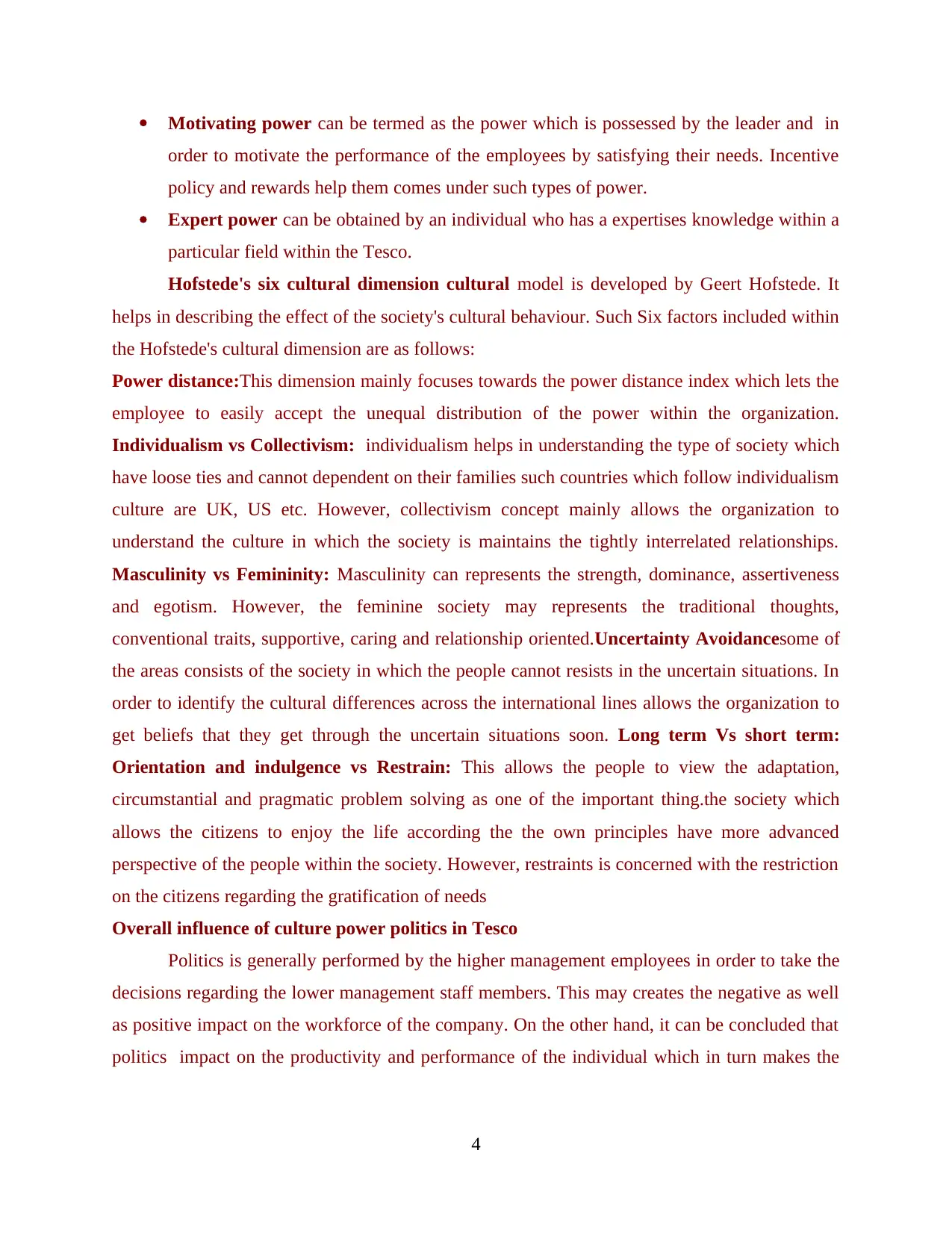
Motivating power can be termed as the power which is possessed by the leader and in
order to motivate the performance of the employees by satisfying their needs. Incentive
policy and rewards help them comes under such types of power.
Expert power can be obtained by an individual who has a expertises knowledge within a
particular field within the Tesco.
Hofstede's six cultural dimension cultural model is developed by Geert Hofstede. It
helps in describing the effect of the society's cultural behaviour. Such Six factors included within
the Hofstede's cultural dimension are as follows:
Power distance:This dimension mainly focuses towards the power distance index which lets the
employee to easily accept the unequal distribution of the power within the organization.
Individualism vs Collectivism: individualism helps in understanding the type of society which
have loose ties and cannot dependent on their families such countries which follow individualism
culture are UK, US etc. However, collectivism concept mainly allows the organization to
understand the culture in which the society is maintains the tightly interrelated relationships.
Masculinity vs Femininity: Masculinity can represents the strength, dominance, assertiveness
and egotism. However, the feminine society may represents the traditional thoughts,
conventional traits, supportive, caring and relationship oriented.Uncertainty Avoidancesome of
the areas consists of the society in which the people cannot resists in the uncertain situations. In
order to identify the cultural differences across the international lines allows the organization to
get beliefs that they get through the uncertain situations soon. Long term Vs short term:
Orientation and indulgence vs Restrain: This allows the people to view the adaptation,
circumstantial and pragmatic problem solving as one of the important thing.the society which
allows the citizens to enjoy the life according the the own principles have more advanced
perspective of the people within the society. However, restraints is concerned with the restriction
on the citizens regarding the gratification of needs
Overall influence of culture power politics in Tesco
Politics is generally performed by the higher management employees in order to take the
decisions regarding the lower management staff members. This may creates the negative as well
as positive impact on the workforce of the company. On the other hand, it can be concluded that
politics impact on the productivity and performance of the individual which in turn makes the
4
order to motivate the performance of the employees by satisfying their needs. Incentive
policy and rewards help them comes under such types of power.
Expert power can be obtained by an individual who has a expertises knowledge within a
particular field within the Tesco.
Hofstede's six cultural dimension cultural model is developed by Geert Hofstede. It
helps in describing the effect of the society's cultural behaviour. Such Six factors included within
the Hofstede's cultural dimension are as follows:
Power distance:This dimension mainly focuses towards the power distance index which lets the
employee to easily accept the unequal distribution of the power within the organization.
Individualism vs Collectivism: individualism helps in understanding the type of society which
have loose ties and cannot dependent on their families such countries which follow individualism
culture are UK, US etc. However, collectivism concept mainly allows the organization to
understand the culture in which the society is maintains the tightly interrelated relationships.
Masculinity vs Femininity: Masculinity can represents the strength, dominance, assertiveness
and egotism. However, the feminine society may represents the traditional thoughts,
conventional traits, supportive, caring and relationship oriented.Uncertainty Avoidancesome of
the areas consists of the society in which the people cannot resists in the uncertain situations. In
order to identify the cultural differences across the international lines allows the organization to
get beliefs that they get through the uncertain situations soon. Long term Vs short term:
Orientation and indulgence vs Restrain: This allows the people to view the adaptation,
circumstantial and pragmatic problem solving as one of the important thing.the society which
allows the citizens to enjoy the life according the the own principles have more advanced
perspective of the people within the society. However, restraints is concerned with the restriction
on the citizens regarding the gratification of needs
Overall influence of culture power politics in Tesco
Politics is generally performed by the higher management employees in order to take the
decisions regarding the lower management staff members. This may creates the negative as well
as positive impact on the workforce of the company. On the other hand, it can be concluded that
politics impact on the productivity and performance of the individual which in turn makes the
4
⊘ This is a preview!⊘
Do you want full access?
Subscribe today to unlock all pages.

Trusted by 1+ million students worldwide
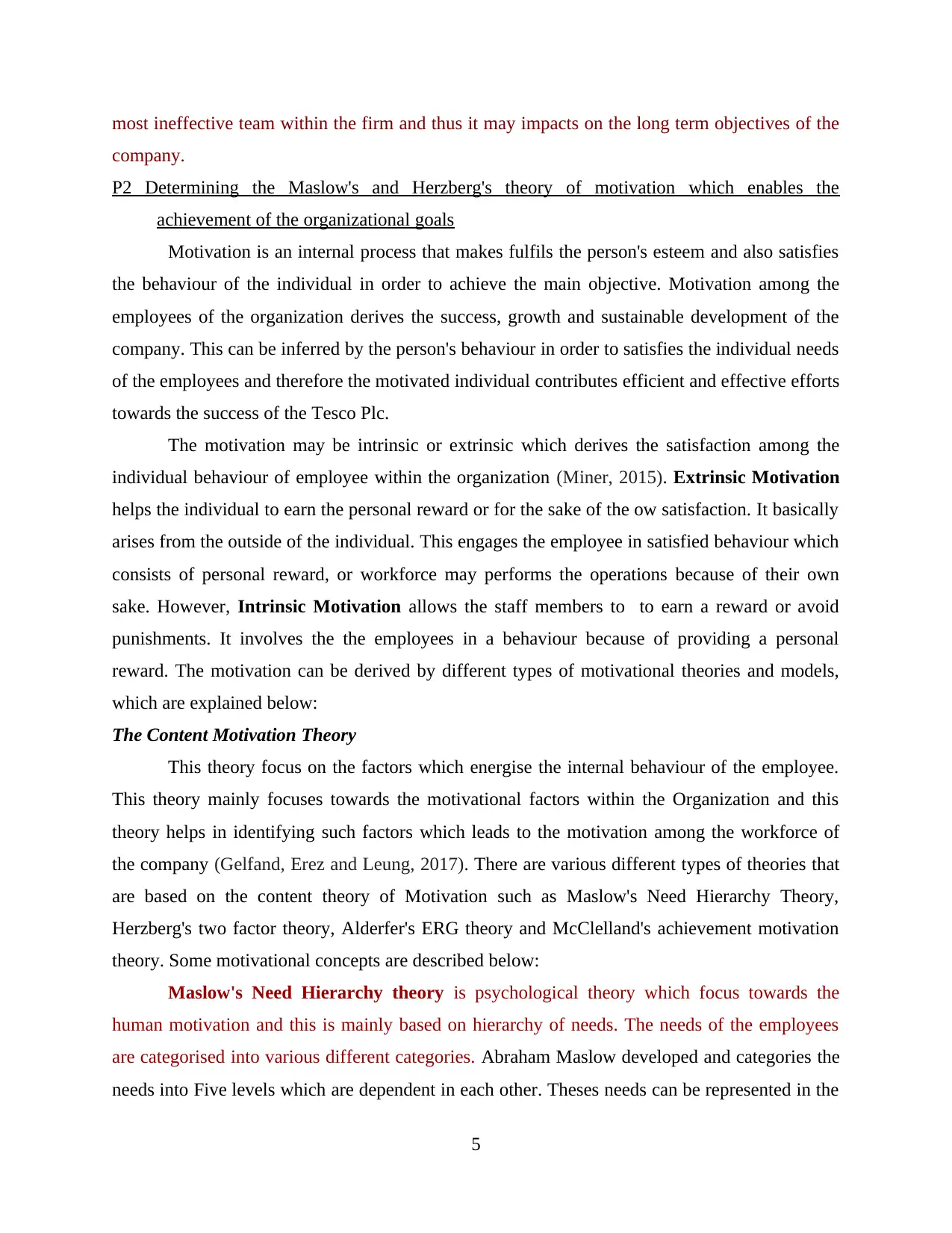
most ineffective team within the firm and thus it may impacts on the long term objectives of the
company.
P2 Determining the Maslow's and Herzberg's theory of motivation which enables the
achievement of the organizational goals
Motivation is an internal process that makes fulfils the person's esteem and also satisfies
the behaviour of the individual in order to achieve the main objective. Motivation among the
employees of the organization derives the success, growth and sustainable development of the
company. This can be inferred by the person's behaviour in order to satisfies the individual needs
of the employees and therefore the motivated individual contributes efficient and effective efforts
towards the success of the Tesco Plc.
The motivation may be intrinsic or extrinsic which derives the satisfaction among the
individual behaviour of employee within the organization (Miner, 2015). Extrinsic Motivation
helps the individual to earn the personal reward or for the sake of the ow satisfaction. It basically
arises from the outside of the individual. This engages the employee in satisfied behaviour which
consists of personal reward, or workforce may performs the operations because of their own
sake. However, Intrinsic Motivation allows the staff members to to earn a reward or avoid
punishments. It involves the the employees in a behaviour because of providing a personal
reward. The motivation can be derived by different types of motivational theories and models,
which are explained below:
The Content Motivation Theory
This theory focus on the factors which energise the internal behaviour of the employee.
This theory mainly focuses towards the motivational factors within the Organization and this
theory helps in identifying such factors which leads to the motivation among the workforce of
the company (Gelfand, Erez and Leung, 2017). There are various different types of theories that
are based on the content theory of Motivation such as Maslow's Need Hierarchy Theory,
Herzberg's two factor theory, Alderfer's ERG theory and McClelland's achievement motivation
theory. Some motivational concepts are described below:
Maslow's Need Hierarchy theory is psychological theory which focus towards the
human motivation and this is mainly based on hierarchy of needs. The needs of the employees
are categorised into various different categories. Abraham Maslow developed and categories the
needs into Five levels which are dependent in each other. Theses needs can be represented in the
5
company.
P2 Determining the Maslow's and Herzberg's theory of motivation which enables the
achievement of the organizational goals
Motivation is an internal process that makes fulfils the person's esteem and also satisfies
the behaviour of the individual in order to achieve the main objective. Motivation among the
employees of the organization derives the success, growth and sustainable development of the
company. This can be inferred by the person's behaviour in order to satisfies the individual needs
of the employees and therefore the motivated individual contributes efficient and effective efforts
towards the success of the Tesco Plc.
The motivation may be intrinsic or extrinsic which derives the satisfaction among the
individual behaviour of employee within the organization (Miner, 2015). Extrinsic Motivation
helps the individual to earn the personal reward or for the sake of the ow satisfaction. It basically
arises from the outside of the individual. This engages the employee in satisfied behaviour which
consists of personal reward, or workforce may performs the operations because of their own
sake. However, Intrinsic Motivation allows the staff members to to earn a reward or avoid
punishments. It involves the the employees in a behaviour because of providing a personal
reward. The motivation can be derived by different types of motivational theories and models,
which are explained below:
The Content Motivation Theory
This theory focus on the factors which energise the internal behaviour of the employee.
This theory mainly focuses towards the motivational factors within the Organization and this
theory helps in identifying such factors which leads to the motivation among the workforce of
the company (Gelfand, Erez and Leung, 2017). There are various different types of theories that
are based on the content theory of Motivation such as Maslow's Need Hierarchy Theory,
Herzberg's two factor theory, Alderfer's ERG theory and McClelland's achievement motivation
theory. Some motivational concepts are described below:
Maslow's Need Hierarchy theory is psychological theory which focus towards the
human motivation and this is mainly based on hierarchy of needs. The needs of the employees
are categorised into various different categories. Abraham Maslow developed and categories the
needs into Five levels which are dependent in each other. Theses needs can be represented in the
5
Paraphrase This Document
Need a fresh take? Get an instant paraphrase of this document with our AI Paraphraser
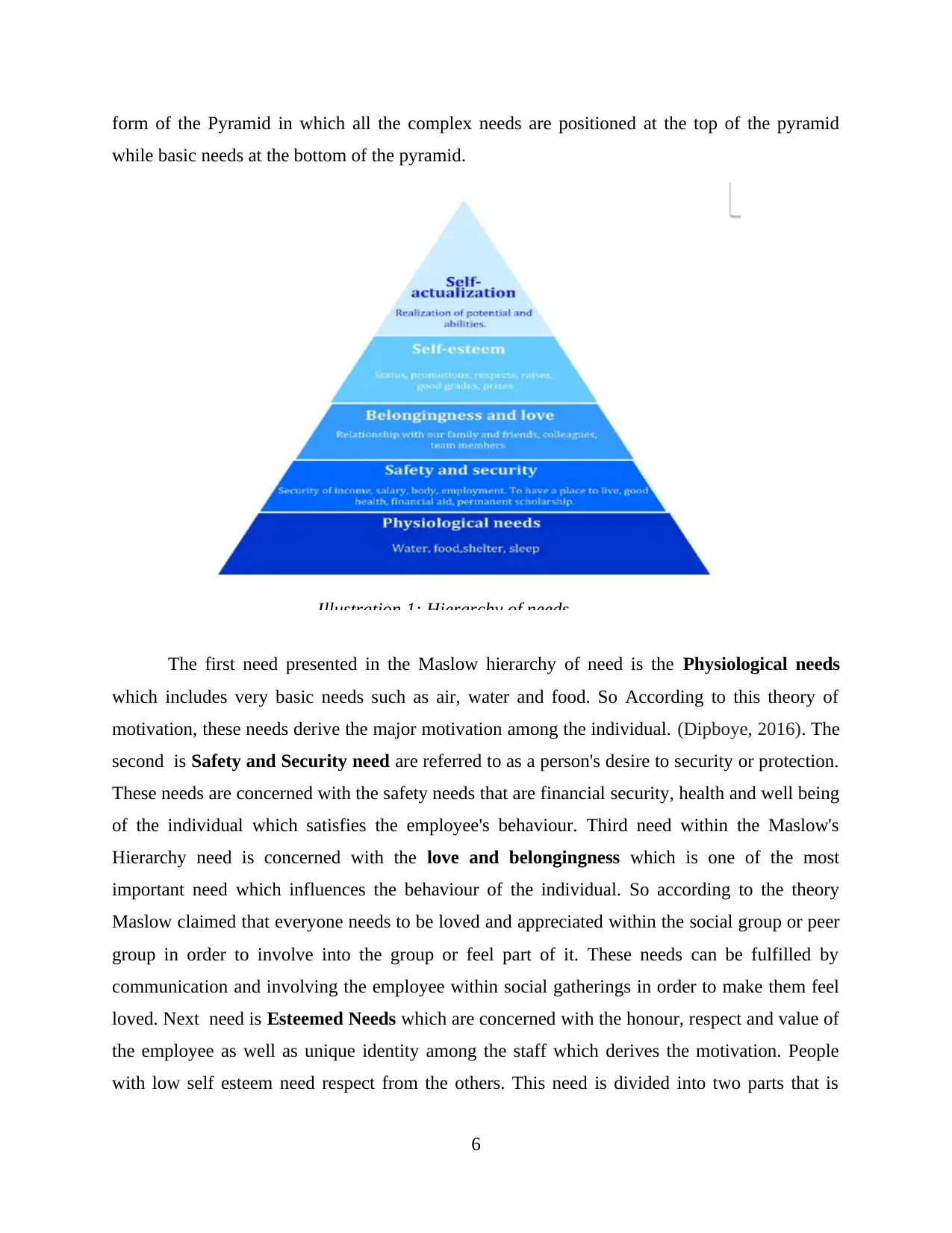
form of the Pyramid in which all the complex needs are positioned at the top of the pyramid
while basic needs at the bottom of the pyramid.
The first need presented in the Maslow hierarchy of need is the Physiological needs
which includes very basic needs such as air, water and food. So According to this theory of
motivation, these needs derive the major motivation among the individual. (Dipboye, 2016). The
second is Safety and Security need are referred to as a person's desire to security or protection.
These needs are concerned with the safety needs that are financial security, health and well being
of the individual which satisfies the employee's behaviour. Third need within the Maslow's
Hierarchy need is concerned with the love and belongingness which is one of the most
important need which influences the behaviour of the individual. So according to the theory
Maslow claimed that everyone needs to be loved and appreciated within the social group or peer
group in order to involve into the group or feel part of it. These needs can be fulfilled by
communication and involving the employee within social gatherings in order to make them feel
loved. Next need is Esteemed Needs which are concerned with the honour, respect and value of
the employee as well as unique identity among the staff which derives the motivation. People
with low self esteem need respect from the others. This need is divided into two parts that is
6
Illustration 1: Hierarchy of needs
while basic needs at the bottom of the pyramid.
The first need presented in the Maslow hierarchy of need is the Physiological needs
which includes very basic needs such as air, water and food. So According to this theory of
motivation, these needs derive the major motivation among the individual. (Dipboye, 2016). The
second is Safety and Security need are referred to as a person's desire to security or protection.
These needs are concerned with the safety needs that are financial security, health and well being
of the individual which satisfies the employee's behaviour. Third need within the Maslow's
Hierarchy need is concerned with the love and belongingness which is one of the most
important need which influences the behaviour of the individual. So according to the theory
Maslow claimed that everyone needs to be loved and appreciated within the social group or peer
group in order to involve into the group or feel part of it. These needs can be fulfilled by
communication and involving the employee within social gatherings in order to make them feel
loved. Next need is Esteemed Needs which are concerned with the honour, respect and value of
the employee as well as unique identity among the staff which derives the motivation. People
with low self esteem need respect from the others. This need is divided into two parts that is
6
Illustration 1: Hierarchy of needs
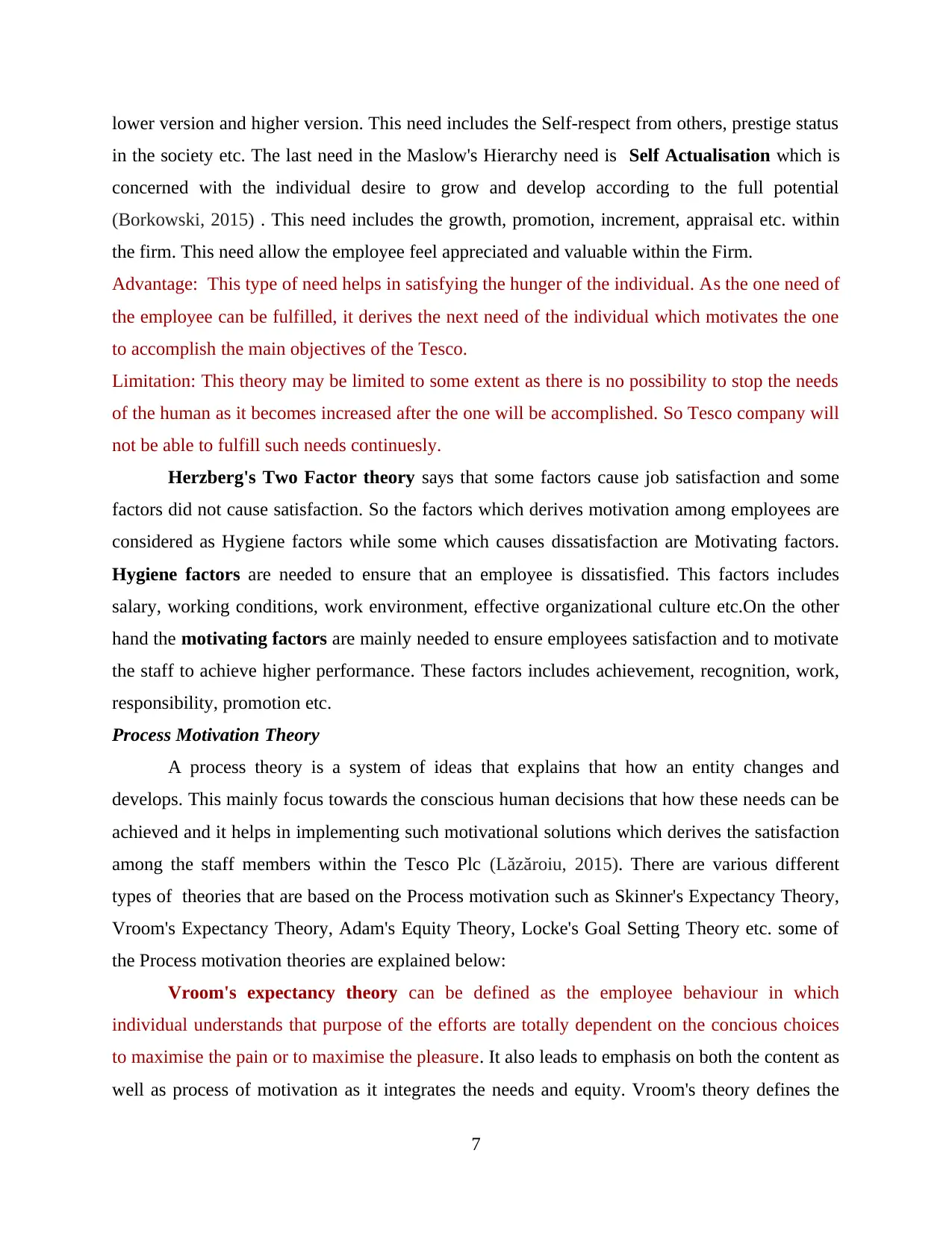
lower version and higher version. This need includes the Self-respect from others, prestige status
in the society etc. The last need in the Maslow's Hierarchy need is Self Actualisation which is
concerned with the individual desire to grow and develop according to the full potential
(Borkowski, 2015) . This need includes the growth, promotion, increment, appraisal etc. within
the firm. This need allow the employee feel appreciated and valuable within the Firm.
Advantage: This type of need helps in satisfying the hunger of the individual. As the one need of
the employee can be fulfilled, it derives the next need of the individual which motivates the one
to accomplish the main objectives of the Tesco.
Limitation: This theory may be limited to some extent as there is no possibility to stop the needs
of the human as it becomes increased after the one will be accomplished. So Tesco company will
not be able to fulfill such needs continuesly.
Herzberg's Two Factor theory says that some factors cause job satisfaction and some
factors did not cause satisfaction. So the factors which derives motivation among employees are
considered as Hygiene factors while some which causes dissatisfaction are Motivating factors.
Hygiene factors are needed to ensure that an employee is dissatisfied. This factors includes
salary, working conditions, work environment, effective organizational culture etc.On the other
hand the motivating factors are mainly needed to ensure employees satisfaction and to motivate
the staff to achieve higher performance. These factors includes achievement, recognition, work,
responsibility, promotion etc.
Process Motivation Theory
A process theory is a system of ideas that explains that how an entity changes and
develops. This mainly focus towards the conscious human decisions that how these needs can be
achieved and it helps in implementing such motivational solutions which derives the satisfaction
among the staff members within the Tesco Plc (Lăzăroiu, 2015). There are various different
types of theories that are based on the Process motivation such as Skinner's Expectancy Theory,
Vroom's Expectancy Theory, Adam's Equity Theory, Locke's Goal Setting Theory etc. some of
the Process motivation theories are explained below:
Vroom's expectancy theory can be defined as the employee behaviour in which
individual understands that purpose of the efforts are totally dependent on the concious choices
to maximise the pain or to maximise the pleasure. It also leads to emphasis on both the content as
well as process of motivation as it integrates the needs and equity. Vroom's theory defines the
7
in the society etc. The last need in the Maslow's Hierarchy need is Self Actualisation which is
concerned with the individual desire to grow and develop according to the full potential
(Borkowski, 2015) . This need includes the growth, promotion, increment, appraisal etc. within
the firm. This need allow the employee feel appreciated and valuable within the Firm.
Advantage: This type of need helps in satisfying the hunger of the individual. As the one need of
the employee can be fulfilled, it derives the next need of the individual which motivates the one
to accomplish the main objectives of the Tesco.
Limitation: This theory may be limited to some extent as there is no possibility to stop the needs
of the human as it becomes increased after the one will be accomplished. So Tesco company will
not be able to fulfill such needs continuesly.
Herzberg's Two Factor theory says that some factors cause job satisfaction and some
factors did not cause satisfaction. So the factors which derives motivation among employees are
considered as Hygiene factors while some which causes dissatisfaction are Motivating factors.
Hygiene factors are needed to ensure that an employee is dissatisfied. This factors includes
salary, working conditions, work environment, effective organizational culture etc.On the other
hand the motivating factors are mainly needed to ensure employees satisfaction and to motivate
the staff to achieve higher performance. These factors includes achievement, recognition, work,
responsibility, promotion etc.
Process Motivation Theory
A process theory is a system of ideas that explains that how an entity changes and
develops. This mainly focus towards the conscious human decisions that how these needs can be
achieved and it helps in implementing such motivational solutions which derives the satisfaction
among the staff members within the Tesco Plc (Lăzăroiu, 2015). There are various different
types of theories that are based on the Process motivation such as Skinner's Expectancy Theory,
Vroom's Expectancy Theory, Adam's Equity Theory, Locke's Goal Setting Theory etc. some of
the Process motivation theories are explained below:
Vroom's expectancy theory can be defined as the employee behaviour in which
individual understands that purpose of the efforts are totally dependent on the concious choices
to maximise the pain or to maximise the pleasure. It also leads to emphasis on both the content as
well as process of motivation as it integrates the needs and equity. Vroom's theory defines the
7
⊘ This is a preview!⊘
Do you want full access?
Subscribe today to unlock all pages.

Trusted by 1+ million students worldwide
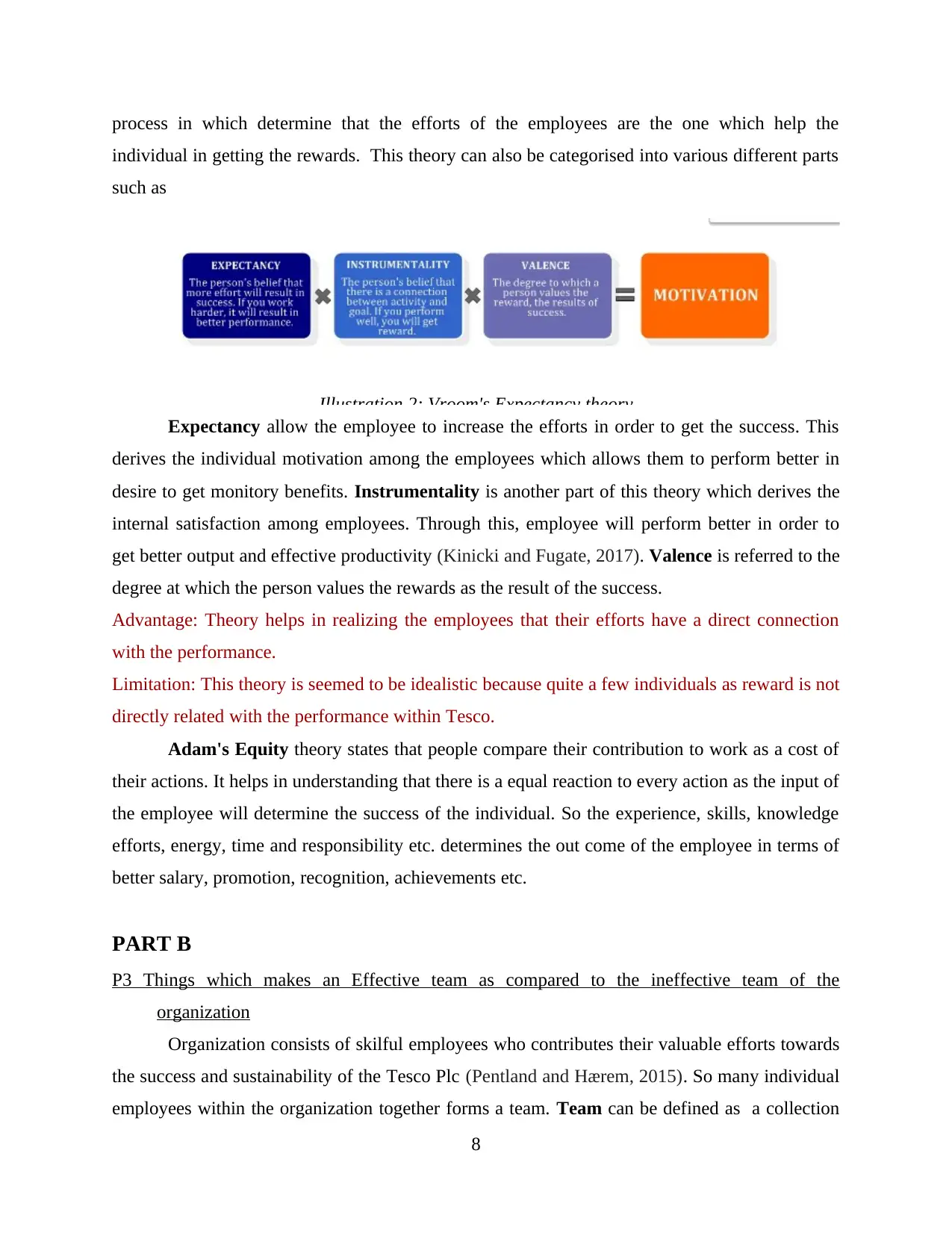
process in which determine that the efforts of the employees are the one which help the
individual in getting the rewards. This theory can also be categorised into various different parts
such as
Expectancy allow the employee to increase the efforts in order to get the success. This
derives the individual motivation among the employees which allows them to perform better in
desire to get monitory benefits. Instrumentality is another part of this theory which derives the
internal satisfaction among employees. Through this, employee will perform better in order to
get better output and effective productivity (Kinicki and Fugate, 2017). Valence is referred to the
degree at which the person values the rewards as the result of the success.
Advantage: Theory helps in realizing the employees that their efforts have a direct connection
with the performance.
Limitation: This theory is seemed to be idealistic because quite a few individuals as reward is not
directly related with the performance within Tesco.
Adam's Equity theory states that people compare their contribution to work as a cost of
their actions. It helps in understanding that there is a equal reaction to every action as the input of
the employee will determine the success of the individual. So the experience, skills, knowledge
efforts, energy, time and responsibility etc. determines the out come of the employee in terms of
better salary, promotion, recognition, achievements etc.
PART B
P3 Things which makes an Effective team as compared to the ineffective team of the
organization
Organization consists of skilful employees who contributes their valuable efforts towards
the success and sustainability of the Tesco Plc (Pentland and Hærem, 2015). So many individual
employees within the organization together forms a team. Team can be defined as a collection
8
Illustration 2: Vroom's Expectancy theory
individual in getting the rewards. This theory can also be categorised into various different parts
such as
Expectancy allow the employee to increase the efforts in order to get the success. This
derives the individual motivation among the employees which allows them to perform better in
desire to get monitory benefits. Instrumentality is another part of this theory which derives the
internal satisfaction among employees. Through this, employee will perform better in order to
get better output and effective productivity (Kinicki and Fugate, 2017). Valence is referred to the
degree at which the person values the rewards as the result of the success.
Advantage: Theory helps in realizing the employees that their efforts have a direct connection
with the performance.
Limitation: This theory is seemed to be idealistic because quite a few individuals as reward is not
directly related with the performance within Tesco.
Adam's Equity theory states that people compare their contribution to work as a cost of
their actions. It helps in understanding that there is a equal reaction to every action as the input of
the employee will determine the success of the individual. So the experience, skills, knowledge
efforts, energy, time and responsibility etc. determines the out come of the employee in terms of
better salary, promotion, recognition, achievements etc.
PART B
P3 Things which makes an Effective team as compared to the ineffective team of the
organization
Organization consists of skilful employees who contributes their valuable efforts towards
the success and sustainability of the Tesco Plc (Pentland and Hærem, 2015). So many individual
employees within the organization together forms a team. Team can be defined as a collection
8
Illustration 2: Vroom's Expectancy theory
Paraphrase This Document
Need a fresh take? Get an instant paraphrase of this document with our AI Paraphraser
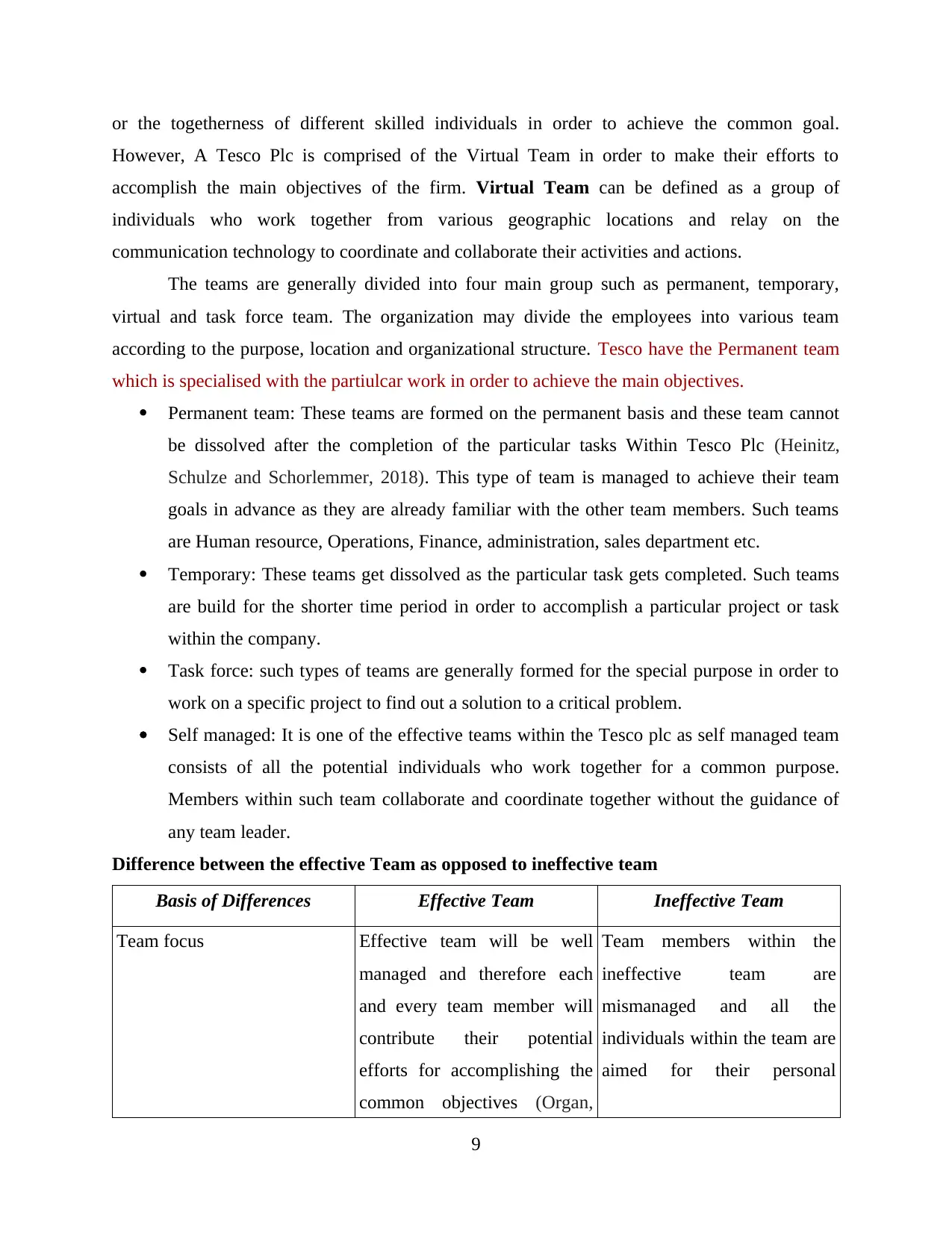
or the togetherness of different skilled individuals in order to achieve the common goal.
However, A Tesco Plc is comprised of the Virtual Team in order to make their efforts to
accomplish the main objectives of the firm. Virtual Team can be defined as a group of
individuals who work together from various geographic locations and relay on the
communication technology to coordinate and collaborate their activities and actions.
The teams are generally divided into four main group such as permanent, temporary,
virtual and task force team. The organization may divide the employees into various team
according to the purpose, location and organizational structure. Tesco have the Permanent team
which is specialised with the partiulcar work in order to achieve the main objectives.
Permanent team: These teams are formed on the permanent basis and these team cannot
be dissolved after the completion of the particular tasks Within Tesco Plc (Heinitz,
Schulze and Schorlemmer, 2018). This type of team is managed to achieve their team
goals in advance as they are already familiar with the other team members. Such teams
are Human resource, Operations, Finance, administration, sales department etc.
Temporary: These teams get dissolved as the particular task gets completed. Such teams
are build for the shorter time period in order to accomplish a particular project or task
within the company.
Task force: such types of teams are generally formed for the special purpose in order to
work on a specific project to find out a solution to a critical problem.
Self managed: It is one of the effective teams within the Tesco plc as self managed team
consists of all the potential individuals who work together for a common purpose.
Members within such team collaborate and coordinate together without the guidance of
any team leader.
Difference between the effective Team as opposed to ineffective team
Basis of Differences Effective Team Ineffective Team
Team focus Effective team will be well
managed and therefore each
and every team member will
contribute their potential
efforts for accomplishing the
common objectives (Organ,
Team members within the
ineffective team are
mismanaged and all the
individuals within the team are
aimed for their personal
9
However, A Tesco Plc is comprised of the Virtual Team in order to make their efforts to
accomplish the main objectives of the firm. Virtual Team can be defined as a group of
individuals who work together from various geographic locations and relay on the
communication technology to coordinate and collaborate their activities and actions.
The teams are generally divided into four main group such as permanent, temporary,
virtual and task force team. The organization may divide the employees into various team
according to the purpose, location and organizational structure. Tesco have the Permanent team
which is specialised with the partiulcar work in order to achieve the main objectives.
Permanent team: These teams are formed on the permanent basis and these team cannot
be dissolved after the completion of the particular tasks Within Tesco Plc (Heinitz,
Schulze and Schorlemmer, 2018). This type of team is managed to achieve their team
goals in advance as they are already familiar with the other team members. Such teams
are Human resource, Operations, Finance, administration, sales department etc.
Temporary: These teams get dissolved as the particular task gets completed. Such teams
are build for the shorter time period in order to accomplish a particular project or task
within the company.
Task force: such types of teams are generally formed for the special purpose in order to
work on a specific project to find out a solution to a critical problem.
Self managed: It is one of the effective teams within the Tesco plc as self managed team
consists of all the potential individuals who work together for a common purpose.
Members within such team collaborate and coordinate together without the guidance of
any team leader.
Difference between the effective Team as opposed to ineffective team
Basis of Differences Effective Team Ineffective Team
Team focus Effective team will be well
managed and therefore each
and every team member will
contribute their potential
efforts for accomplishing the
common objectives (Organ,
Team members within the
ineffective team are
mismanaged and all the
individuals within the team are
aimed for their personal
9
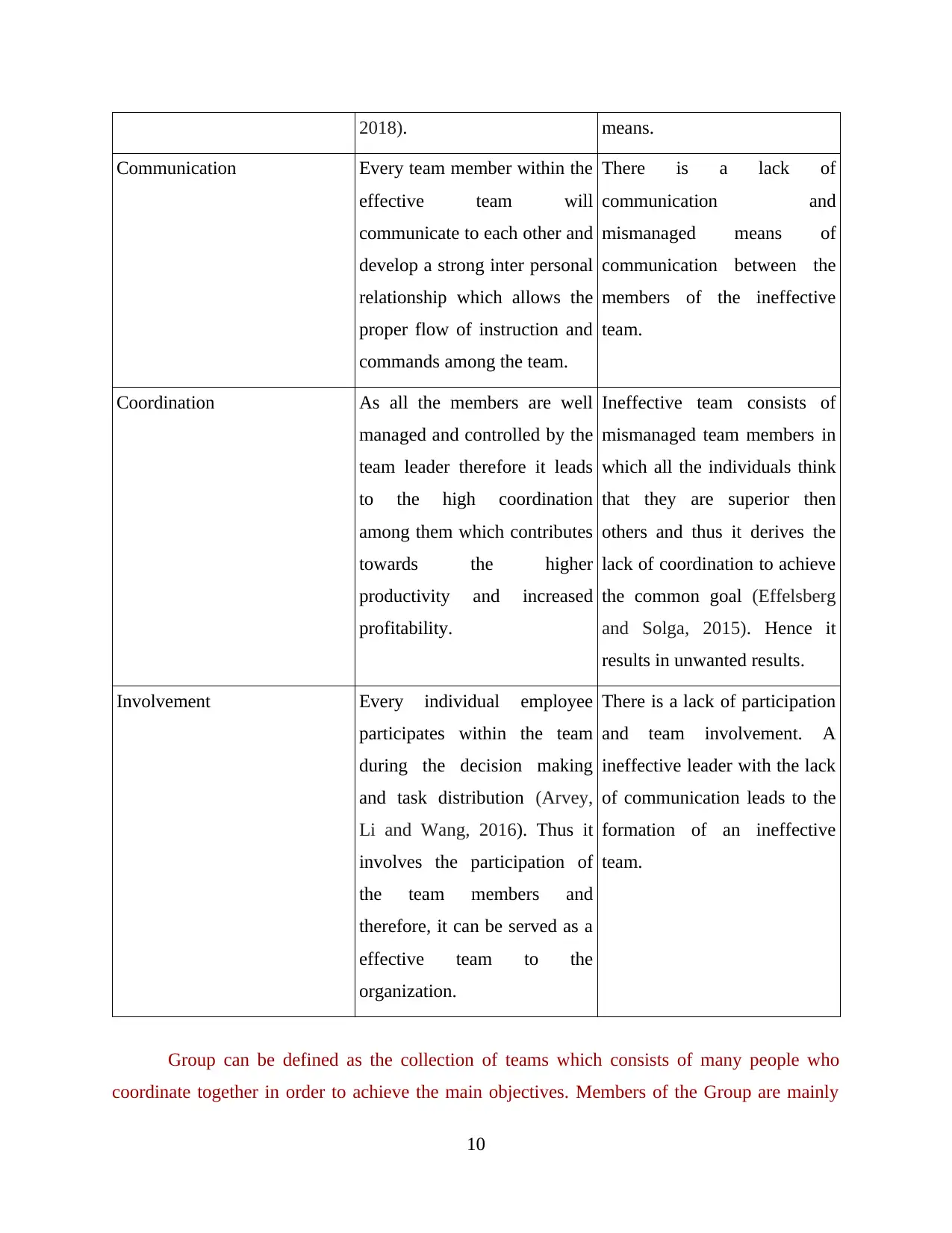
2018). means.
Communication Every team member within the
effective team will
communicate to each other and
develop a strong inter personal
relationship which allows the
proper flow of instruction and
commands among the team.
There is a lack of
communication and
mismanaged means of
communication between the
members of the ineffective
team.
Coordination As all the members are well
managed and controlled by the
team leader therefore it leads
to the high coordination
among them which contributes
towards the higher
productivity and increased
profitability.
Ineffective team consists of
mismanaged team members in
which all the individuals think
that they are superior then
others and thus it derives the
lack of coordination to achieve
the common goal (Effelsberg
and Solga, 2015). Hence it
results in unwanted results.
Involvement Every individual employee
participates within the team
during the decision making
and task distribution (Arvey,
Li and Wang, 2016). Thus it
involves the participation of
the team members and
therefore, it can be served as a
effective team to the
organization.
There is a lack of participation
and team involvement. A
ineffective leader with the lack
of communication leads to the
formation of an ineffective
team.
Group can be defined as the collection of teams which consists of many people who
coordinate together in order to achieve the main objectives. Members of the Group are mainly
10
Communication Every team member within the
effective team will
communicate to each other and
develop a strong inter personal
relationship which allows the
proper flow of instruction and
commands among the team.
There is a lack of
communication and
mismanaged means of
communication between the
members of the ineffective
team.
Coordination As all the members are well
managed and controlled by the
team leader therefore it leads
to the high coordination
among them which contributes
towards the higher
productivity and increased
profitability.
Ineffective team consists of
mismanaged team members in
which all the individuals think
that they are superior then
others and thus it derives the
lack of coordination to achieve
the common goal (Effelsberg
and Solga, 2015). Hence it
results in unwanted results.
Involvement Every individual employee
participates within the team
during the decision making
and task distribution (Arvey,
Li and Wang, 2016). Thus it
involves the participation of
the team members and
therefore, it can be served as a
effective team to the
organization.
There is a lack of participation
and team involvement. A
ineffective leader with the lack
of communication leads to the
formation of an ineffective
team.
Group can be defined as the collection of teams which consists of many people who
coordinate together in order to achieve the main objectives. Members of the Group are mainly
10
⊘ This is a preview!⊘
Do you want full access?
Subscribe today to unlock all pages.

Trusted by 1+ million students worldwide
1 out of 21
Related Documents
Your All-in-One AI-Powered Toolkit for Academic Success.
+13062052269
info@desklib.com
Available 24*7 on WhatsApp / Email
![[object Object]](/_next/static/media/star-bottom.7253800d.svg)
Unlock your academic potential
Copyright © 2020–2025 A2Z Services. All Rights Reserved. Developed and managed by ZUCOL.




